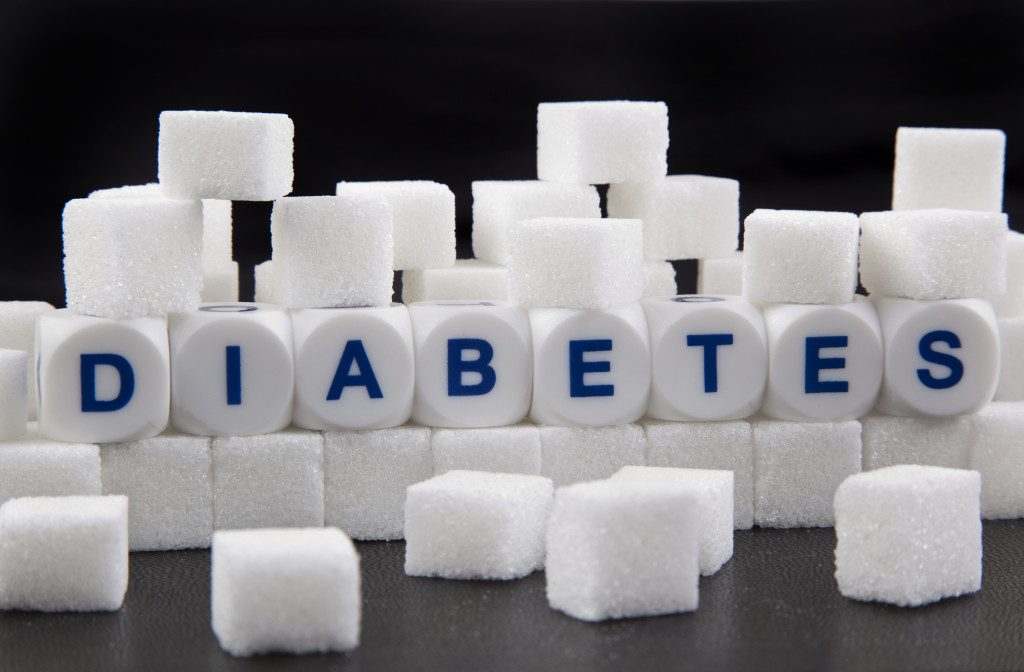Some people call diabetes, sugar – as in, “I have a touch of sugar” or “I lost my leg to the sugar.” I think the reference to sugar is easier to process than the more formal term—diabetes. Either way, diabetes, or “the sugar,” is heavily entwined in weight management.
Although I have always struggled  with my weight and have family members with both type 1 and type 2 diabetes, I never gave it much thought until I developed gestational diabetes with my first pregnancy. In 1992, I was thrilled to be pregnant after undergoing some medical assistance to get there. At 20 weeks the doctor did a routine screening for gestational diabetes, and my reading was really high. I was given dietary instructions to reduce all sugar, except I could have a piece of fruit in the morning. I was to cut out as many carbs as possible and test my blood sugar four times a day and take insulin twice per day. I started out trying to follow the rules, but life was hectic and I didn’t really understand the consequences of gestational diabetes on me or my unborn child. I was hospitalized a day before Christmas so that my doctor could get my blood sugars stabilized. I went on to have a C-Section, and thank goodness 22 years later, my son has not shown any signs of diabetes. I was much more compliant when I got pregnant with my second son and lost 30 pounds, but the doctor still had to put me on insulin to manage the climbing blood sugars. I didn’t have any additional interactions with diabetes until I reached age 42 and my blood sugars began creeping up again. If diabetes prevention programs were as widely available then as they are today, my doctor likely would have recommended that I participate one to help cut my risk of developing type 2 diabetes.
with my weight and have family members with both type 1 and type 2 diabetes, I never gave it much thought until I developed gestational diabetes with my first pregnancy. In 1992, I was thrilled to be pregnant after undergoing some medical assistance to get there. At 20 weeks the doctor did a routine screening for gestational diabetes, and my reading was really high. I was given dietary instructions to reduce all sugar, except I could have a piece of fruit in the morning. I was to cut out as many carbs as possible and test my blood sugar four times a day and take insulin twice per day. I started out trying to follow the rules, but life was hectic and I didn’t really understand the consequences of gestational diabetes on me or my unborn child. I was hospitalized a day before Christmas so that my doctor could get my blood sugars stabilized. I went on to have a C-Section, and thank goodness 22 years later, my son has not shown any signs of diabetes. I was much more compliant when I got pregnant with my second son and lost 30 pounds, but the doctor still had to put me on insulin to manage the climbing blood sugars. I didn’t have any additional interactions with diabetes until I reached age 42 and my blood sugars began creeping up again. If diabetes prevention programs were as widely available then as they are today, my doctor likely would have recommended that I participate one to help cut my risk of developing type 2 diabetes.
My primary care doctor kept urging me to lose weight, but rarely followed up with suggestions of how to do it. By age 45, I had developed full blown type 2 diabetes. By the time I had weight loss surgery in 2013, my A1C had reached 10. I knew it was way too high. Since that time, I’ve kept my average blood sugars lower, with an A1C under 6.5 despite significant weight re-gain, mostly because I try to walk several times per week.
Saturday, November 14 is World Diabetes Day. It is a time to raise awareness about how to prevent and manage diabetes. In North Carolina, we are launching a guide to diabetes prevention and management to help individuals prevent and manage diabetes and to help community members, employers, and health care providers create environments that support diabetes prevention and management. At the core of diabetes prevention and management are weight management, healthy eating and increased physical activity. There are lots of tools available through MyEatSmartMoveMore.com that can help people live healthy, and if they are like me, it will also help them either avoid or better manage “the sugar.”
To learn more about North Carolina’s Guide to Diabetes Prevention and Management being released on December 4, visit www.DiabetesNC.com.
